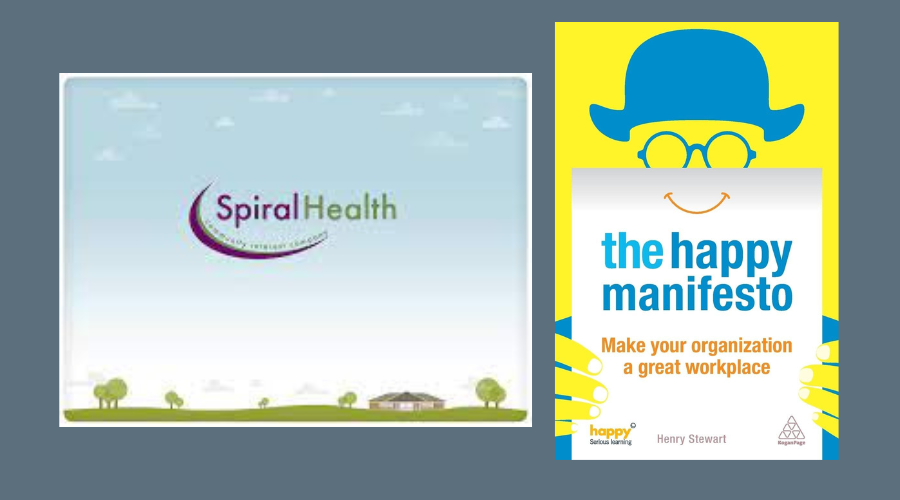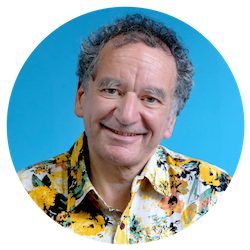How Spiral Health Implemented The Happy Manifesto
Publishing the Happy Manifesto has led to a lot of organisations contacting Happy. Some call us in to help them improve their workplace and we love doing this. But there is an even bigger thrill when I get a letter from somebody we’ve not been involved with, who has taken the Manifesto and put the ideas into practice. So I’m delighted to copy the blog below, originally published on the Spiral Health site, about the work they are doing at an NHS site in Lancashire.
Hi, we are Happy
We are leading a movement to create happy, empowered and productive workplaces.
How can we help you and your people to find joy in at least 80% of your work?

“Imagine a workplace where people are energised and motivated by being in control of the work they do. Imagine they are trusted and given freedom, within clear guidelines, to decide how to achieve their results. Wouldn’t you want to work there?”
I love this quote from ‘The Happy Manifesto’ by Henry Stewart and, yes, I’d love to work in an organisation like that. I believe these are principles all managers should aspire to. But, more than this, I believe that only a happy, motivated team can provide a superior level of customer service. What it boils down to at Spiral Health is that we can’t be truly patient-centred unless we are person-centred with our staff.
When it comes to being person-centred with staff, the buck stops with the senior management team – me included. Our philosophy is to be visible and approachable. We regularly walk the wards, talking to patients and visitors and we are extremely open and accessible to staff. As an aside, Happy Manifesto rule 4 is to be open and transparent – I hope our staff would say that we do this well.
That’s not enough, though. Staff need a voice. They need to feel that their views are listened to and valued. Unusually for a healthcare setting, two staff members sit on the board of Spiral Health as non-executive directors. Normally, non-executive directors would be chosen from outside an organisation, but because we are mutually owned, we felt it was imperative for our staff to have this board-level representation.
We also have three very active working groups – an operations group, a business development group and a workforce group. Each group is facilitated by a staff member and attended by a complete mix of staff, representing all aspects of our operation, from nurses to administrators. Our working groups inform all our important decisions and although group membership is voluntary, the majority of staff do attend and engage with the process positively.
It’s fair to say that when we first set up the working groups, some staff felt the meetings were negative and those who were less confident in a group setting often felt unable to contribute. We invested in specialised training (we learned how to run Positive and Productive Meetings) and now the meetings buzz with energy and even the quieter staff are very vocal.
Our business development group works hard on our strategic vision at Spiral Health. It considers how we should grow as a social enterprise. For example, it considers whether we should tender for London-based projects or stay local.
Our operations group is very focused on our Bispham unit. This group considers big issues, such as our Care Quality Commission reports, but also handles the smaller things that are key to making our unit thrive. Thanks to this group we have Easter eggs at Easter, celebrations at Christmas and – following a brainwave from one group member – special non-slip slippers available for patients to buy.
The workforce group focuses on the nitty-gritty of our operations. It is in these group meetings that we use ‘The Happy Manifesto’ as a source of ideas and inspiration. Henry Stewart’s management philosophy has influenced everything from our corporate vision and core values to our recruitment processes and performance reviews.
Another important way we are person-centred with staff is by involving them in our continuous change process, Working Together for Change. During this process patient feedback is scrutinised by a team of stakeholders representing the entire organisation – and the action points agreed truly reflect all viewpoints.
Our working group structure isn’t perfect yet. As with every aspect of our patient-centred work, this is a moving feast. One thing I can report, though, is that running an organisation that is actively person-centred with its staff makes me…. happy.
Tracey Bush
Related blogs
- The Benefits of Happy Workplaces in the Public Sector — Happy workplaces aren't just beneficial to private companies, they also increase productivity in the public sector and NGOs.
- Happy Workplaces are More Successful — Read the evidence that proves the link between happiness at work and success.
- The Happy Manifesto: 10 Steps to a Great Workplace — Henry has picked out 10 points from his book The Happy Manifesto to help you transform your workplace.
- Can you Use Happy Manifesto Principles in a Charity? — In this 15 minute video Michelle Hill talks about implementing Happy Manifesto principles at the charity TLC.
Keep informed about happy workplaces
Sign up to Henry's monthly Happy Manifesto newsletter, full of tips and inspiration to help you to create a happy, engaged workplace.

Learn the 10 core principles to create a happy and productive workplace in Henry Stewart's book, The Happy Manifesto.
Henry's Most Popular Blogs
- 8 Companies That Celebrate Mistakes
- 9 Benefits of Having Happy Employees
- 321Zero: How I Solved my Email Overload
- 16 Companies That Don't Have Managers
- 5 Big Companies Who Swear by Mindfulness
- 49 Steps to a Happy Workplace
- A Four Day Week? Let's Start With a Four Day August
- Google: Hire Great People and Give Them Lots of Autonomy
- Buurtzorg: No Managers, Just Great Care From a Nurse-Led Service
- 30 Steps to Joy at Work: Get More Done by Being Less Busy

Henry Stewart, Founder and Chief Happiness Officer
Henry is founder and Chief Happiness Officer of Happy Ltd, originally set up as Happy Computers in 1987. Inspired by Ricardo Semler’s book Maverick, he has built a company which has won multiple awards for some of the best customer service in the country and being one of the UK’s best places to work.
Henry was listed in the Guru Radar of the Thinkers 50 list of the most influential management thinkers in the world. "He is one of the thinkers who we believe will shape the future of business," explained list compiler Stuart Crainer.
His first book, Relax, was published in 2009. His second book, the Happy Manifesto, was published in 2013 and was short-listed for Business Book of the Year.
You can find Henry on LinkedIn and follow @happyhenry on Twitter.
Next Conference: Women in Leadership Online Conference
Save the date for our online conference on 12th November 2025, celebrating women in leadership.
You will hear from inspiring female leaders about how they have created happy and empowered workplaces.
There will be interaction, discussion, space for reflection and opportunities to network with other leaders.
Related courses
The Happy Leadership Programme
Brave Leadership: One-Year Leadership Development Programme for Women
Level 7 Senior Leadership Apprenticeship Programme
Not what you need? Take a look at all of our off-the-shelf Leadership and Management programmes.